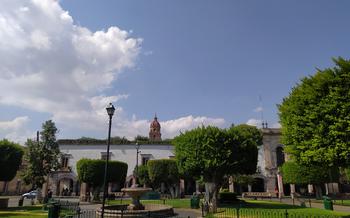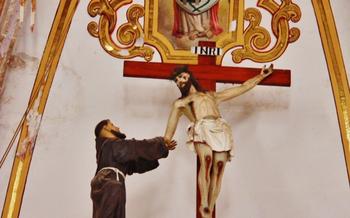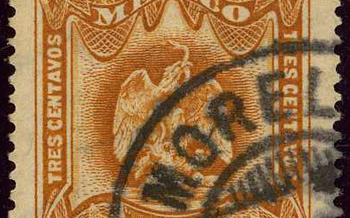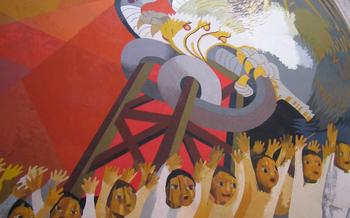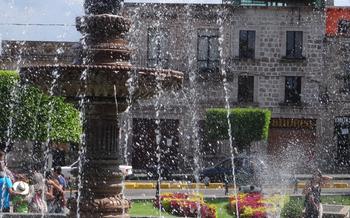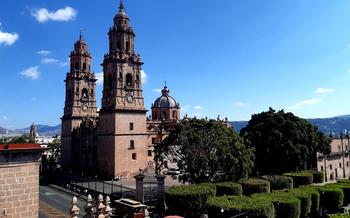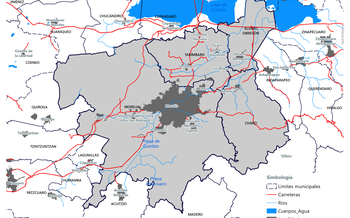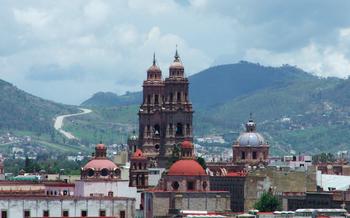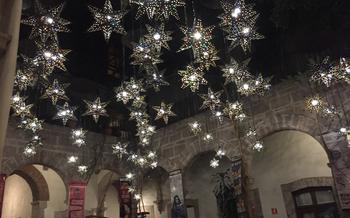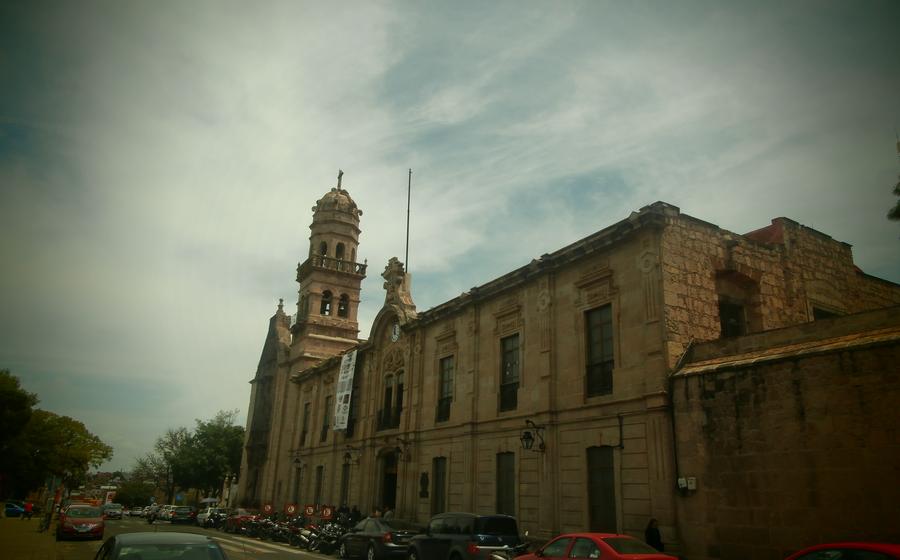
Ex Convento de San Diego
- The Ex Convento de San Diego: A Historical Gem
- Exploring the Courtyard: A Tranquil Oasis
- The Museo de Arte Colonial: A Treasure Trove of Art
- The Biblioteca Pública de Morelia: A Haven for Book Lovers
- The Claustro Menor: A Place of Contemplation
- The Templo de San Diego: A Place of Worship
- The Mercado de Dulces: A Sweet Treat for Visitors
- The Acueducto de Morelia: A Marvel of Engineering
- Insider Tip: The Best Time to Visit
The Ex Convento de San Diego: A Historical Gem
In the heart of Morelia, a city renowned for its colonial architecture and rich history, stands the Ex Convento de San Diego, a testament to the grandeur of Mexico's past. Founded in 1573 by the Franciscan order, this sprawling complex served as a monastery and a center of religious devotion for over three centuries. Its construction marked the beginning of a new era in Morelia's history, transforming it into a significant religious and cultural hub.
The Ex Convento de San Diego is a masterpiece of Plateresque architecture, characterized by its intricate ornamentation and harmonious proportions. The convent's facade is a symphony of stone carvings, with delicate reliefs adorning the doorway and windows. The interior is equally impressive, boasting vaulted ceilings, elegant arches, and a serene courtyard that exudes tranquility.
In 1999, the Ex Convento de San Diego was declared a UNESCO World Heritage Site, recognizing its outstanding universal value. Today, this architectural marvel stands as a symbol of Mexico's cultural heritage, attracting visitors from around the world who come to admire its beauty and immerse themselves in its history. Ongoing preservation efforts ensure that this architectural gem continues to captivate and inspire generations to come.
Exploring the Courtyard: A Tranquil Oasis
In the heart of the Ex Convento de San Diego, a serene courtyard beckons travelers to unwind and soak in the tranquil ambiance. Designed with meticulous care, the courtyard features a harmonious layout, with lush greenery, vibrant flowers, and elegant arches creating a picturesque haven.
Notable architectural elements adorn the courtyard, capturing the eyes of visitors. Intricate columns, delicate frescoes, and ornate fountains showcase the artistic prowess of the convent's builders. Amidst this symphony of artistry, a fountain stands as the centerpiece, its gentle murmur adding to the courtyard's serene atmosphere.
The courtyard exudes a palpable sense of peace, a sanctuary from the bustling city outside. The gentle breeze rustles through the leaves, creating a soothing melody that lulls visitors into a state of tranquility. In this tranquil oasis, time seems to slow down, allowing for quiet contemplation and reflection.
One fond memory from my visit to the Ex Convento de San Diego vividly stands out. As I sat in the courtyard, surrounded by the beauty of nature and architecture, a sense of serenity washed over me. The world's worries melted away, replaced by a profound sense of calm. It was a moment etched in my memory, a reminder of the transformative power of this special place.
The Museo de Arte Colonial: A Treasure Trove of Art
The Museo de Arte Colonial, housed within the Ex Convento de San Diego, is a treasure trove of colonial-era art. The collection boasts an impressive array of paintings, sculptures, and religious artifacts, offering a glimpse into the artistic traditions of Mexico during the colonial period. Among the notable artworks is a striking sculpture of the Virgin Mary, carved in the 16th century from a single block of wood. The intricate details and lifelike features of the statue are a testament to the skill and artistry of the indigenous craftsmen who created it. Another highlight of the collection is a series of paintings depicting the life of Saint Francis of Assisi. These works, created in the 17th century, showcase the vibrant colors and expressive style characteristic of Mexican colonial art.
In addition to these masterpieces, the museum also houses a collection of everyday objects that provide insight into the daily lives of the monks who resided in the convent. These include ceramic plates, cooking utensils, and furniture, all of which offer a glimpse into the domestic life of the monastery. The Museo de Arte Colonial is a must-visit for anyone interested in the art and history of Mexico. Its collection provides a unique window into the country's colonial past and showcases the exceptional artistry of the period.
The Biblioteca Pública de Morelia: A Haven for Book Lovers
The Biblioteca Pública de Morelia, nestled within the historic center of Morelia, stands as a testament to the city's rich cultural heritage. Founded in 1740, it ranks among Mexico's oldest libraries and boasts an impressive collection of over 300,000 books and manuscripts.
The library's collection spans a diverse range of subjects, from history and literature to philosophy and religion. It houses rare editions, ancient manuscripts, and invaluable documents that offer a glimpse into Mexico's past. Among its prized possessions are first editions of works by renowned Mexican authors such as Sor Juana Inés de la Cruz and Octavio Paz.
The Biblioteca Pública de Morelia is not merely a repository of books; it is a place where history comes alive. Its architectural features, such as the grand staircase and the ornate reading rooms, contribute to its charm and elegance. The library's atmosphere is one of quiet contemplation and scholarly pursuit, inviting visitors to delve into the world of knowledge.
I recall a particular visit to the library when I stumbled upon a hidden gem among the shelves. It was a beautifully illustrated manuscript dating back to the 16th century, detailing the history of the region. The intricate drawings and elegant calligraphy transported me back in time, offering a glimpse into the lives of our ancestors.
The Biblioteca Pública de Morelia is more than just a collection of books; it is a cultural treasure that preserves the intellectual and literary heritage of Mexico. Whether you are a history buff, a literature enthusiast, or simply someone seeking a tranquil space for contemplation, this library is a must-visit destination.
The Claustro Menor: A Place of Contemplation
In the heart of the Ex Convento de San Diego, nestled between the Biblioteca Pública de Morelia and the Capilla Abierta, lies the Claustro Menor, a serene and contemplative space that invites visitors to pause and reflect. This cloister, with its serene atmosphere, served as a place of retreat and meditation for the Augustinian monks who once resided in the convent.
The Claustro Menor's layout is simple yet elegant, featuring a square courtyard surrounded by arched walkways. The walls are adorned with intricate frescoes depicting religious scenes and the lives of saints, adding a touch of spirituality to the space. The center of the courtyard is adorned with a fountain, its gentle splashing providing a soothing backdrop for contemplation.
The atmosphere in the Claustro Menor is one of tranquility and peace, making it an ideal place for quiet reflection. The soft footsteps of visitors echo through the arched walkways, and the only other sounds are the gentle chirping of birds and the rustling of leaves in the breeze. It is easy to imagine the monks of old, seeking solace and inspiration within these walls.
One afternoon, as I wandered through the Ex Convento de San Diego, I stumbled upon the Claustro Menor. Intrigued by its peaceful aura, I stepped inside and found myself transported to a different time and place. I sat on one of the stone benches, surrounded by centuries-old frescoes, and allowed the serenity of the space to wash over me. It was a moment of profound peace and reflection, a reminder of the power of silence and contemplation.
The Templo de San Diego: A Place of Worship
The Templo de San Diego is the spiritual heart of the Ex Convento de San Diego. Constructed in the 16th century, this magnificent church showcases a harmonious blend of Gothic and Renaissance architectural styles. Its imposing façade is adorned with intricate carvings and sculptures, reflecting the artistic and religious fervor of the time. Inside, the church boasts a breathtakingly ornate interior. The vaulted ceilings are adorned with vibrant frescoes depicting scenes from the Bible, while the walls are adorned with elaborate altarpieces and religious iconography.
The Templo de San Diego has played a pivotal role in the religious life of Morelia. For centuries, it has been a place of worship, prayer, and spiritual guidance for the local community. Every Sunday, the church comes alive with the sounds of hymns and the faithful gathering for mass. The atmosphere is one of reverence and devotion, as the congregation prays and seeks solace within these sacred walls.
I had the privilege of attending a religious ceremony in the Templo de San Diego. As I stepped inside, I was immediately struck by the sense of peace and tranquility that enveloped the space. The soft glow of the candles illuminated the intricate details of the altar, casting a warm and inviting light. The congregation was gathered in silent prayer, their heads bowed in humility. As the priest led the service, the air was filled with the sound of their voices, united in faith and devotion.
The Templo de San Diego is more than just a place of worship; it is a symbol of the deep-rooted Catholic traditions that have shaped the cultural identity of Morelia. Its enduring presence is a testament to the enduring power of faith and the importance of spiritual connection in the lives of the local people.
The Mercado de Dulces: A Sweet Treat for Visitors
In the heart of Morelia, nestled among colorful colonial buildings, lies the Mercado de Dulces, a haven for those with a sweet tooth. Steeped in history and tradition, this vibrant market has been tantalizing visitors for centuries with its irresistible array of traditional Mexican sweets. The air is alive with the heady aroma of sugar, cinnamon, and vanilla, as vendors proudly display their handcrafted creations.
From the moment you step into the market, your senses are awakened by the sight of colorful pyramids of candied fruit, glistening trays of chocolate delicacies, and intricate marzipan figurines. Each vendor takes pride in their unique recipes, passed down through generations, ensuring that every sweet is a testament to Mexican culinary heritage.
Among the must-try treats are the "ate," a soft, fruit-based paste often made with guava, quince, or tamarind, and the "cajeta," a thick, caramelized goat's milk that is simply divine. For those who prefer something crunchy, the "borrachitos," rum-soaked cookies, and the "alfajores," filled with dulce de leche and coated in coconut, are sure to satisfy.
As you wander through the market, don't be afraid to engage with the friendly vendors. They are more than happy to share their stories and offer you samples of their delectable creations. Whether you're looking for a sweet souvenir to take home or simply want to indulge your taste buds, the Mercado de Dulces is a must-visit destination.
One particularly memorable experience I had at the market was when I stumbled upon a hidden gem tucked away in a corner. An elderly woman was selling traditional "chongos zamoranos," a type of caramel-coated milk dessert. As I watched her skillfully shape and package each piece, she shared stories about her family's recipe and the importance of preserving these traditional sweets. It was a moment that reminded me of the deep cultural significance that lies behind each bite of these sweet treats.
The Acueducto de Morelia: A Marvel of Engineering
Standing tall and majestic on the outskirts of Morelia, the Acueducto de Morelia is a testament to human ingenuity and engineering prowess. Constructed in the late 18th century, this impressive aqueduct was designed to bring fresh water from the nearby hills to the growing city. Comprising over 250 arches that stretch for nearly 1,700 meters, the aqueduct is a remarkable sight to behold. Its graceful arches and imposing structure blend seamlessly with the surrounding landscape, creating a picturesque scene that has become synonymous with Morelia.
Take a leisurely stroll along the aqueduct's pathways and marvel at the intricate details of its construction. Admire the way the arches soar towards the sky, seemingly defying gravity. The aqueduct is a testament to the skill and dedication of the builders who created it, using only basic tools and techniques. As you walk, imagine the challenges they faced in constructing such a massive structure without the aid of modern machinery.
The Acueducto de Morelia played a crucial role in the development of the city. By providing a reliable water source, it allowed Morelia to grow and prosper. Today, the aqueduct stands as a reminder of the city's rich history and its enduring spirit. While it no longer serves its original purpose, it remains a beloved landmark and a source of pride for the people of Morelia.
Insider Tip: The Best Time to Visit
Morelia's temperate climate makes it a year-round destination with comfortable weather. However, the best time to visit is during the shoulder seasons, from April to May and September to October, when the crowds are smaller, and the temperatures are mild.
During these months, you can stroll through the city's cobblestone streets without battling throngs of tourists and enjoy the many attractions without long lines or wait times. The weather is also ideal for exploring the city's outdoor spaces, such as the Jardín de las Rosas or the Acueducto de Morelia, without the scorching summer heat or the chilly winter winds.
If you plan your visit around one of Morelia's many festivals or events, you'll be in for a treat. The city comes alive during the annual Festival Internacional de Cine de Morelia, which showcases Mexican and international films, and the Festival Internacional de Música de Morelia, which features concerts and performances by world-renowned musicians.
To fully immerse yourself in the city's vibrant culture, be sure to visit during one of these special events. But even if you're simply looking to relax and soak in the colonial charm of Morelia, the shoulder seasons offer the perfect opportunity to do so.
